葡萄酒銷量下滑,唯獨這款酒出人意料熱銷
有人稱,千禧一代扼殺了葡萄酒(連瓶塞都沒有放過)。不管是真是假,但桃紅肯定不在扼殺范圍之列。
相反,桃紅葡萄酒或許正是因為他們才得以崛起。數年前,很多反對者可能會認為桃紅只是曇花一現的事物,但它并未就此消亡。
國際葡萄酒及烈酒研究所的市場分析師萊恩·李說:“在過去很長一段時間里,美國人認為桃紅是一種甜美、果味十足的葡萄酒,其種類因為接受度不高而較為單一。法國生產商通過數年的時間成功地營銷并擴大了桃紅品嘗活動,并借此改變了美國消費者對桃紅的看法。此舉幫助提升了人們對這類酒品的興趣,并極大地豐富了桃紅的品種數量。如今,桃紅已經成為了家喻戶曉、深受人們喜愛的酒品,而且越來越多的生產商,尤其是本土生產商都推出了自有的桃紅干紅。”
然而,盡管法國普羅旺斯產區是桃紅的代言詞,而且美國消費者對桃紅的興趣日漸高漲,但他們也在學習,然后向外延伸,并從其他產區購買桃紅。他們不僅放眼美國和其他新世界紅酒生產商,還將目光瞄向了法國在歐洲的鄰國。這些國家有著類似的氣候,也能夠生產類似品質的紅酒,但單瓶或每箱的價格通常會低很多。

這些紅酒生產商如今有充分的理由來投資桃紅釀造。尼爾森公司稱,美國桃紅酒的銷售額在過去三年中一直保持著同比增長,2019年的增速達到了42%。
國際葡萄酒及烈酒研究所的數據顯示,2019年,桃紅佐餐酒的銷量同比增長了3.2%,而無氣葡萄酒整體出現了1%的下滑。在過去五年中(從2014年到2019年),桃紅斬獲了1.7%的復合年增長率,而整個無氣葡萄酒行業為0.8%。
這家市場研究公司調查了新冠疫情爆發之前桃紅的非現場飲用銷售額,發現其銷量在過去三個月中出現了大幅增長。然而分析師稱,這種從現場飲用(酒吧和餐館)向非現場飲用(零售)轉變,而不是行業整體增長的現象更具代表性。(尼爾森的美國非現場飲用的全口徑衡量渠道包括百貨店、藥店、大型商超、精選一美元店、精選倉儲俱樂部、軍方供應、便利店和烈酒店。)
美國本土佐餐酒的增速要高于進口酒,也帶動了桃紅的整體銷量,但價位卻更低。來自于意大利的桃紅在美國的銷量尤為強勁,銷售額同比增長了近20%,尤其是8美元至11美元的價格區間的桃紅。另一種銷量名列前茅的佐餐桃紅來自于新西蘭,其銷售額同比增長了16%,主力產品位于11美元至15美元的價格區間。
尼爾森的酒精飲品行業高級副總裁丹尼·布拉格說:“法國佐餐桃紅在美國的非現場飲用領域依然在增長,尤其是高價位酒,但其市場份額正在下滑。”國際葡萄酒及烈酒研究所稱,截至2020年2月,法國桃紅銷售份額同比實際上下降了1.7個百分點。去年美國市場上的法國無氣葡萄酒整體銷量下滑了4.9個百分點。
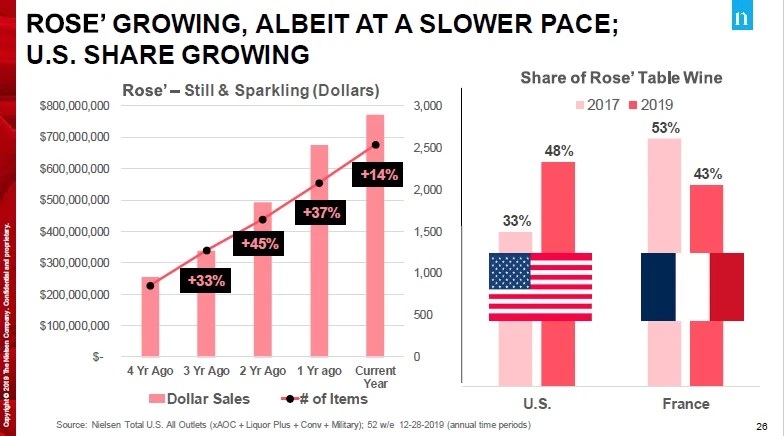
不管怎么樣,法國依然是桃紅市場的霸主,在美國桃紅佐餐酒前十大進口國榜單中排名第一,意大利、新西蘭、西班牙、葡萄牙、阿根廷、智利、澳大利亞、南非和德國緊隨其后。
盡管市場上也有普通價格的法國桃紅,但大多數都屬于高檔酒系列(按照國際葡萄酒及烈酒研究所定義,超過10美元/瓶的葡萄酒)。
李表示:“法國桃紅對于普通消費者來說還是偏貴。”國際葡萄酒及烈酒研究所的研究顯示,美國桃紅佐餐酒平均零售價格為8.32美元。“作為對比,美國本土酒莊生產的桃紅價格更具吸引力。本土酒莊額外的庫存和供給過剩也為新的高品質品牌進入美國市場創造了機會,而且這些品牌的價格比以往更低。”
如今,似乎有無窮無盡的新桃紅品牌在等著消費者去發現。葡萄酒進口商Evaton專營伊比利亞佐餐酒,其首席執行官史蒂芬·布勞爾說:“消費者愿意花更多的錢購買桃紅,但桃紅本身的特質才是讓他們成為回頭客的真正原因。幸運的是,人們無需花太多的錢便可以享用到優質桃紅。”
桃紅類酒品之所以大獲成功,千禧一代比其他年齡段的人士功勞更大。桃紅全球跟蹤網站稱,在過去17年中,桃紅在全球的銷量一直在飆升,2002年至2018年的增速達到了40%。布勞爾說,美國市場的千禧一代消費者想要的是輕盈、口感好的葡萄酒,同時這也是他們追求的生活方式。他說:“桃紅不僅僅是一款夏季飲品,它的特別之處在于價格親民。粉紅色的酒體能夠給任何場合帶來歡愉,適合各種預算類型的消費者。”
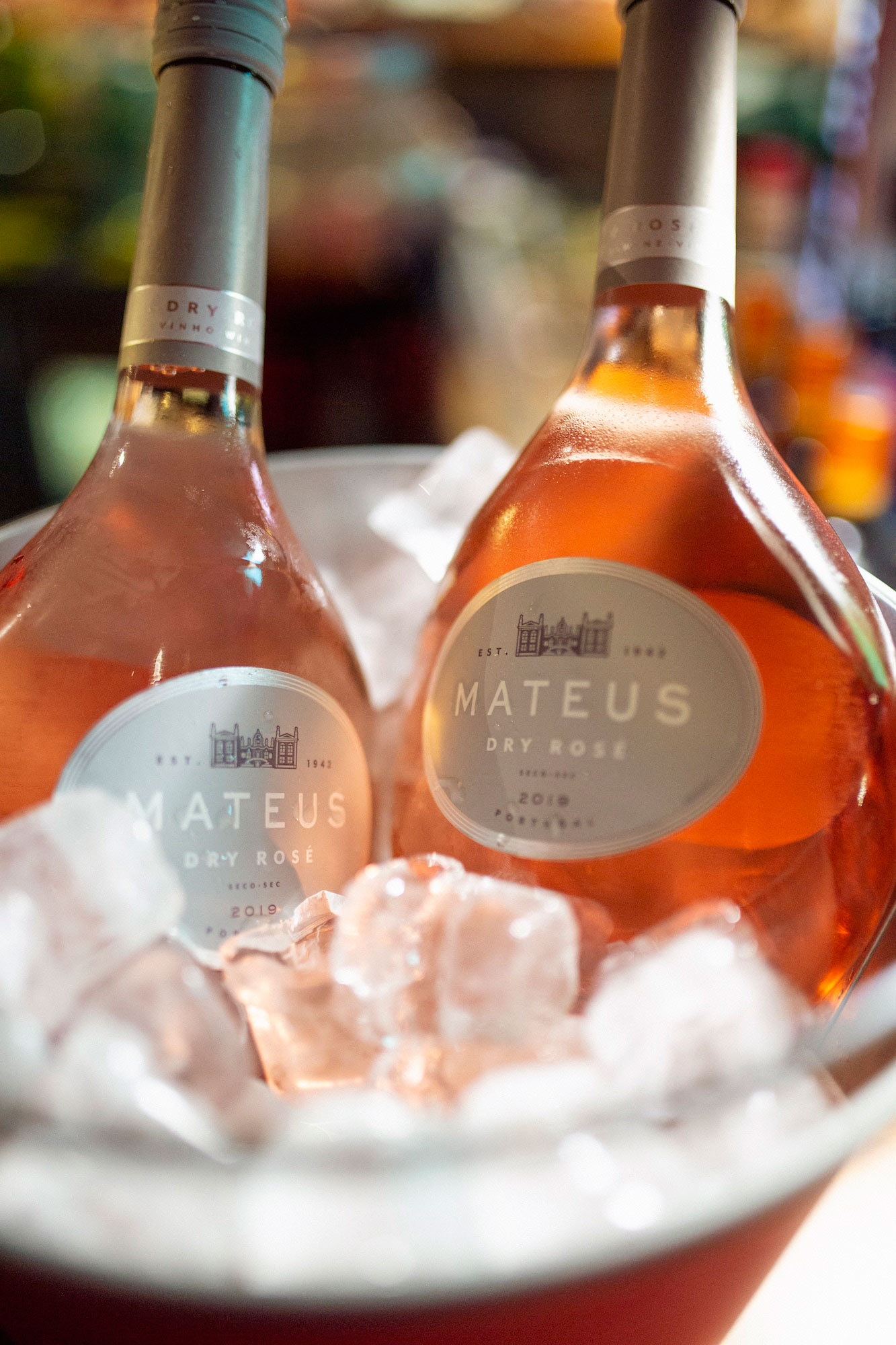
瓶中信息
在消費者繼續尋找下一款劃時代酒品之際,葡萄牙成為了首選替代目標。在新冠疫情爆發以及還未出現非必要旅行這個問題之前,大批美國民眾如潮水般涌向葡萄牙。最近幾年,葡萄牙成為了頂級旅游勝地,而且被世界旅游大獎連續三年(2017-2019)評選為歐洲最佳旅游勝地。《葡萄酒愛好者》還將其評選為2019年10大最佳紅酒旅游勝地。
布勞爾說:“人們在葡萄牙發現,紅酒的性價比出奇的好。桃紅近些年的走紅也源于市場在售桃紅整體品質的大幅提升,而且桃紅的適用場合亦非常廣泛。在全球范圍內,桃紅可以用于勾兌雞尾酒,作為開胃酒,或作為多種夏季菜肴的佐餐酒。”
葡萄牙紅酒制造商蘇加比集團的美國分公司Evaton正在慶祝其Mateus桃紅干紅的重新推出。Mateus是葡萄牙首要的家族酒莊,位于波爾圖東北部,也是蘇加比集團旗下的頂級酒莊之一。1942年,最初的Mateus桃紅被設計和開發為一款甜美的氣泡酒。隨著這些年消費者口味的變化,Mateus也隨之進行了調整(主要針對美國市場),并推出了首款桃紅干紅。布勞爾說:“借助Mateus桃紅干紅,我們根據當前消費者的口味調整了紅酒的口感,而且相信這款不俗的產品可以與法國普羅旺斯頂級桃紅相抗衡。”
Mateus的葡萄酒業務主任安東尼奧·布拉加說:“在我們生產的所有桃紅中,我們最看重的一個元素就是可飲用性,也就是將優雅、迷人的風味和平衡度融于一體。以Mateus桃紅干紅為例,我們追求的是新鮮、果味表達以及完整的酸度,這些都能帶來絕佳的口感。”
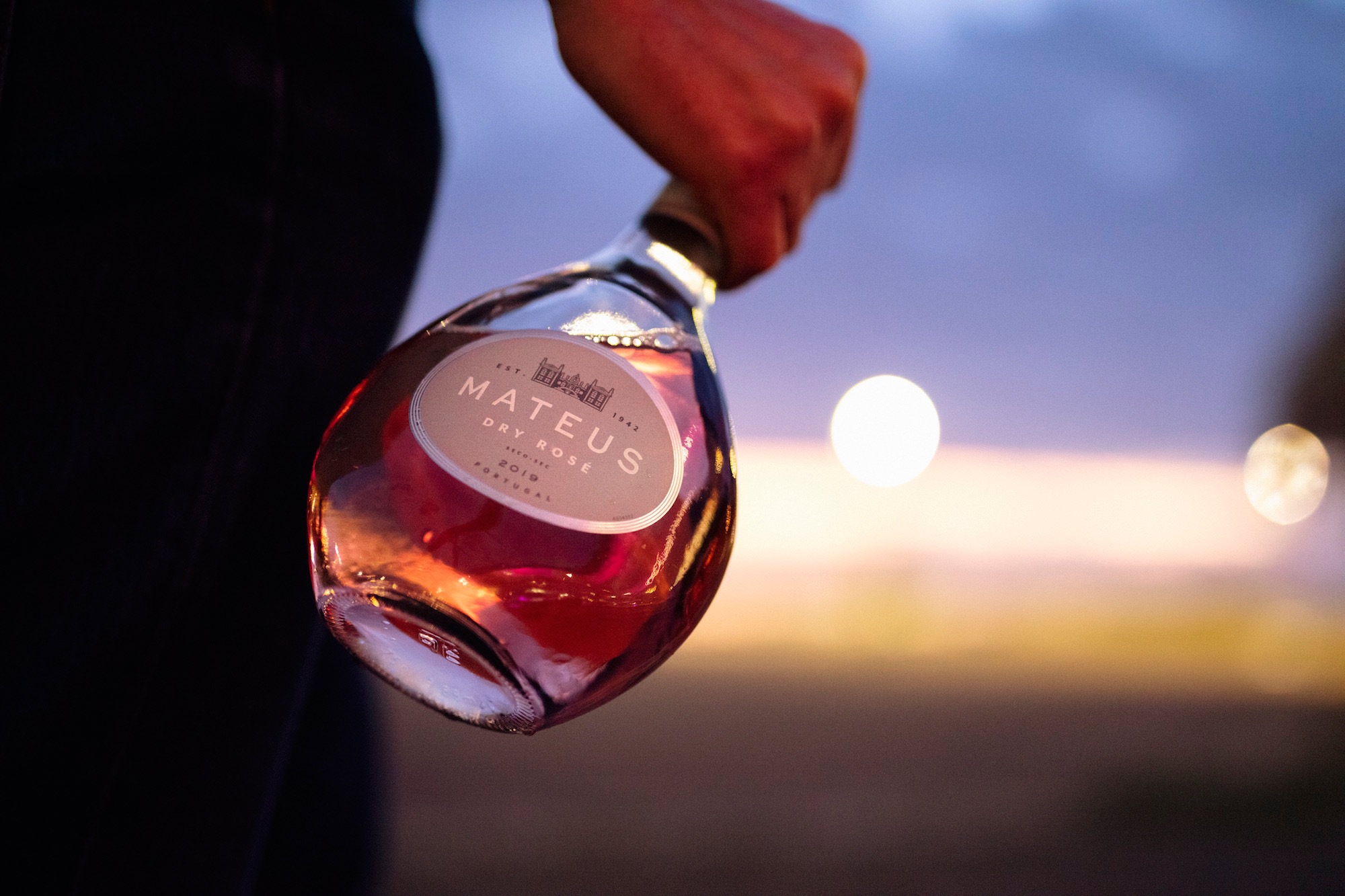
Mateus現已進駐120多個市場,其最大的市場還是其產地葡萄牙。當地的消費能力十分強勁,從2010年的17.9萬箱增至2019年的27.5萬箱。
但美國是Mateus干紅桃紅的唯一市場。蘇加比集團執行委員會委員拉奎爾·瑟布拉說:“在美國,我們根據美國人的口感需求采取了一種不同的前衛方式,并開發了一款干紅桃紅,這是一款有著淺粉酒體,甜度更低的葡萄酒。我們非常專注于通過數字手段來開發品牌,并投入了很多精力來打造我們的社交渠道,我們認為這類渠道體現了Mateus所要表達的生活真諦。粉紅色的葡萄酒、標志性的包裝,以及愛意滿滿的品牌形象這個完美組合有助于我們在社交媒體領域吸引我們的核心目標消費者。”
瑟布拉還提到了在美國消費者心目中大獲成功的幾個外形因素,尤其是其187毫升的瓶體(作為對比的是平均750毫升的標準瓶體)。瑟布拉說:“對消費者來說,這個量在任何場合都是剛剛好,而且瓶體的形狀也是十分獨特。”她解釋說,這個瓶體是一戰期間士兵們所攜帶酒瓶的再現。
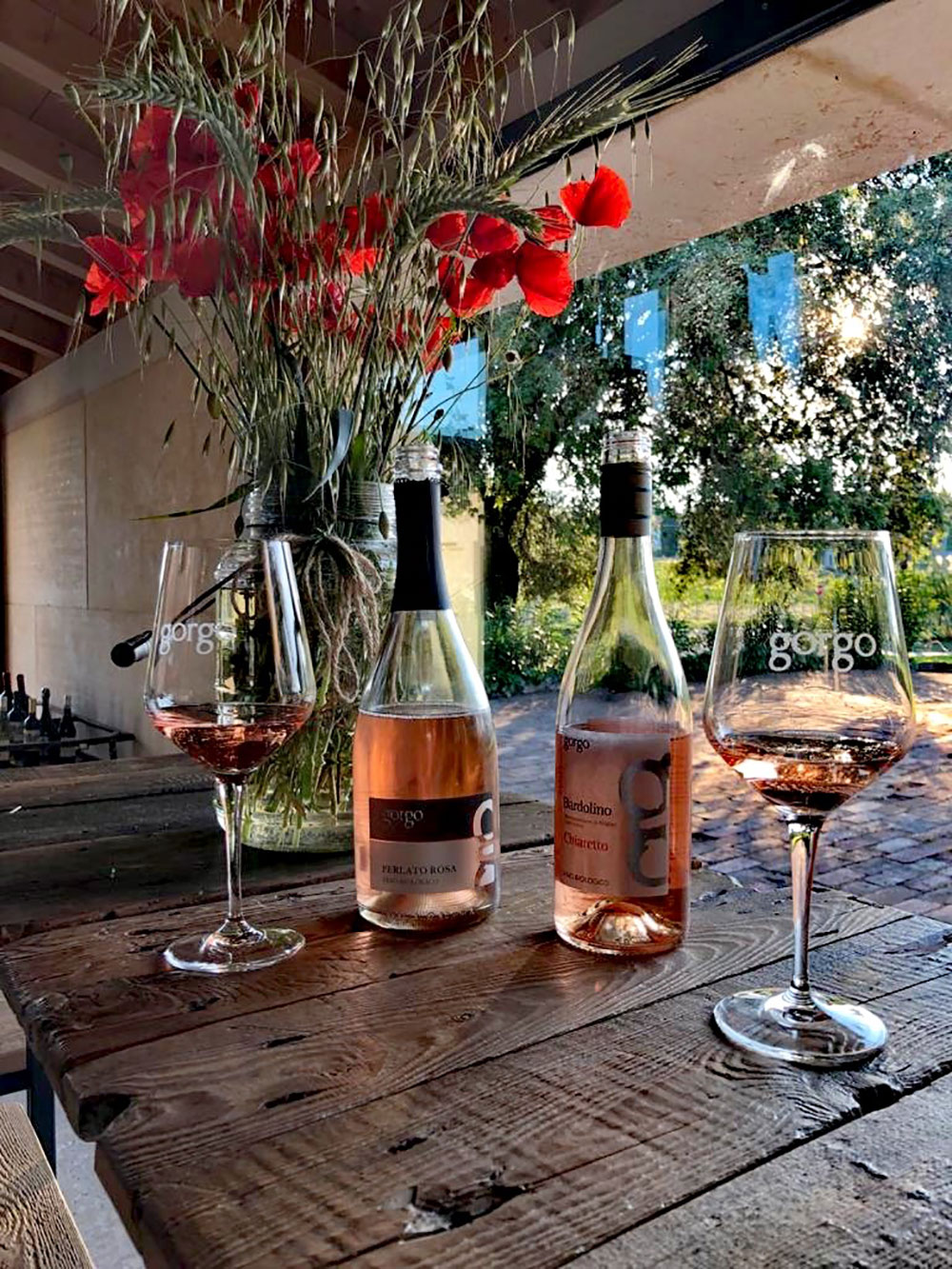
未開發的潛力
尋求意大利夏季飲品的美國民眾如今可能只能選擇阿佩羅雞尾酒。然而,受益于這款Instagram推崇的雞尾酒,意大利桃紅葡萄酒的產量得以大幅提升,而且其銷量近些年來在本土市場以及歐盟和美國市場也迎來了迅猛增長。
Chiaretto是一款有著清爽口感的干紅桃紅,其原料為紅葡萄,采用了白葡萄酒的釀造工藝,產自米蘭和威尼斯之間的加爾達湖周邊地區。(其名稱Chiaretto源于意大利語chiaro,意為“淺色”、“蒼白”。)
加爾達湖是意大利桃紅最重要的產區,每年平均產量超過了1000萬瓶,而桃紅占意大利紅酒市場總量的6%。盡管遭遇新冠疫情,但桃紅的上揚趨勢有望得以延續,而該產區在2020年第一季度發送了260萬支Chiaretto,較2019年第一季度增長了50萬支。
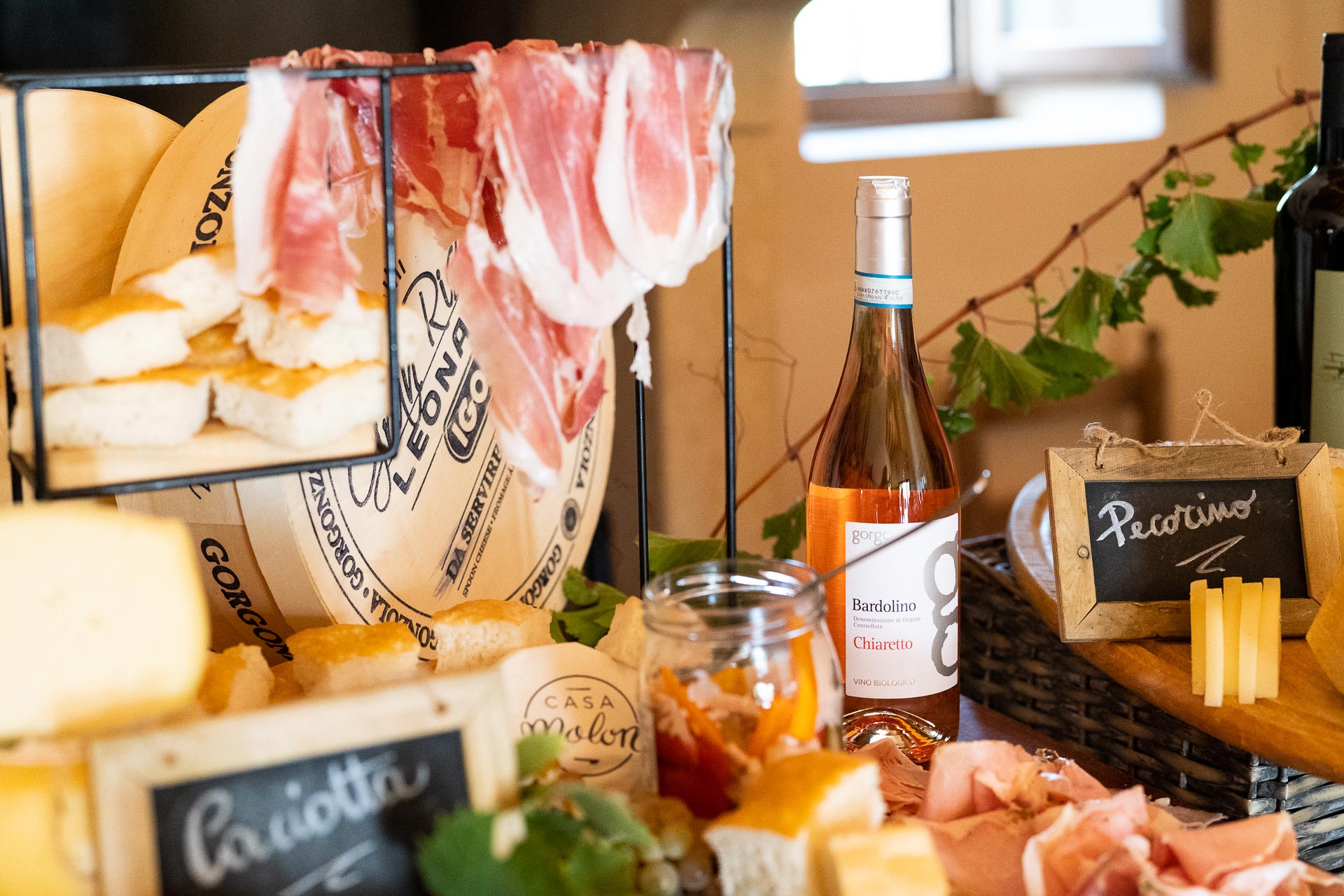
Cantina Gorgo酒莊位于加爾達湖東南部。得益于意大利和海外市場,其Chiaretto銷量在過去三年中增長了60%。該酒莊的主要市場是廣大的歐盟地區,主要是德國。但Gorgo酒莊的聯合所有者、紅酒釀造商羅伯塔·布里克羅稱,最大和最近的訂單需求均來自于美國(尤其是紐約和馬薩諸塞州)、加拿大和英國,同時連鎖超市維特羅斯(Waitrose)已經將Gorgo Chiaretto葡萄酒擺上了旗下所有店面的貨架。
布里克羅說,盡管消費者的初戀可能一直是普羅旺斯產區的桃紅,但她認為全球市場還存在大量未挖掘的潛力。她補充說:“公司崛起的關鍵在于引入意大利在桃紅領域的專長和風味。”
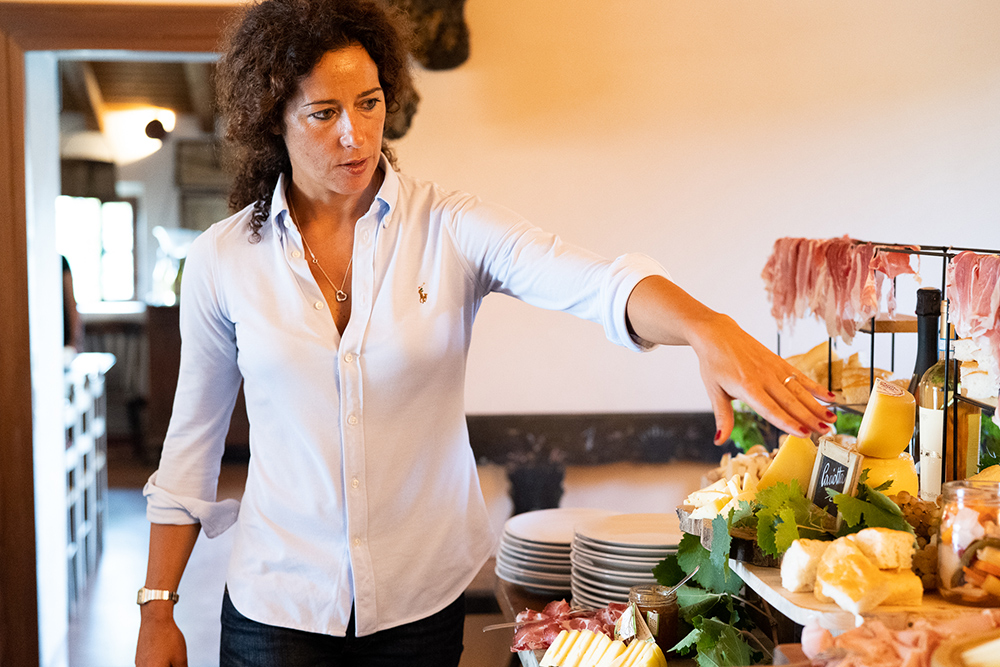
離Gorgo不遠的Cavalchina也迎來了其桃紅銷量的激增,而Chiaretto是其最暢銷的酒品之一。這家酒莊平均每年生產80萬箱葡萄酒,其中有半數出口。但唯一的問題在于,這家酒莊每年的酒都會售罄。2019年,意大利、歐盟地區和美國買光了Cavalchina所有的桃紅,而且酒莊發現這些市場的需求仍在上漲。
盡管銷量在不斷增,擁有110公頃(約合272英畝)的皮奧納家族并不打算擴張或購買更多的土地,因為他們希望這個家族業務能夠可持續地發展下去。
弗朗西斯科·皮奧納說:“說真的,我認為這些趨勢一直都是起起伏伏,目前桃紅也在經歷這一現象。”弗朗西斯科的父親路西阿諾與其兄弟于1962年創建了酒廠。銷售業績顯示,桃紅在近期的需求依然堅挺。但Chiaretto尤為特殊的一點在于,它是少數能夠陳釀的桃紅之一,而且如果放置數年后口感會更好。皮奧納說:“市場需要淺齡酒,但我們的桃紅可以陳釀兩到三年的時間。”
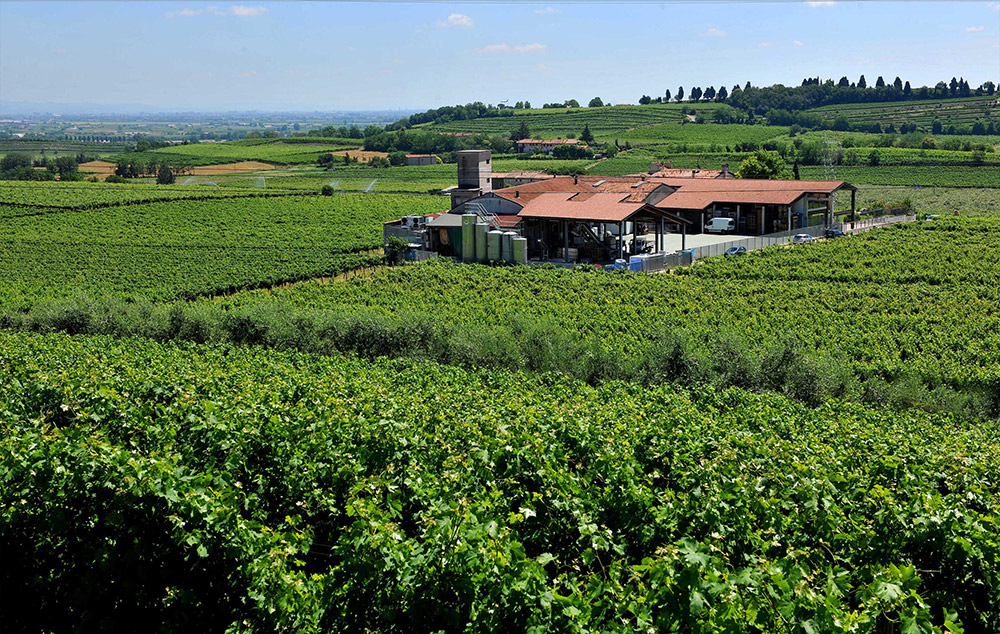
良好的聲譽
美國并不像意大利加達爾湖和法國普羅旺斯那樣有特定的桃紅產區。但行業專家認為加州和俄勒岡州是其有力的競爭對手,涵蓋從圣路易斯奧比斯波一直到威拉梅特谷的地區。
舊金山灣區Cameron Hughes Wine與 Vintage Wine Estates的首席營銷官杰西卡·科甘認為,美國式的桃紅“通常更為順滑和現代”。大多數在這里釀造的桃紅都是干紅,而且通常酒精度較低,也讓其更為適合夏季飲用。
科甘說:“大多數消費者想要一款加州產桃紅,其唯一能感知的甜度來自于葡萄本身的天然紅色水果風味。很多消費者認為桃紅是一種更加純粹的飲酒體驗,因為這種葡萄酒可以輕易地與各種食品搭配,也十分適合獨飲。”
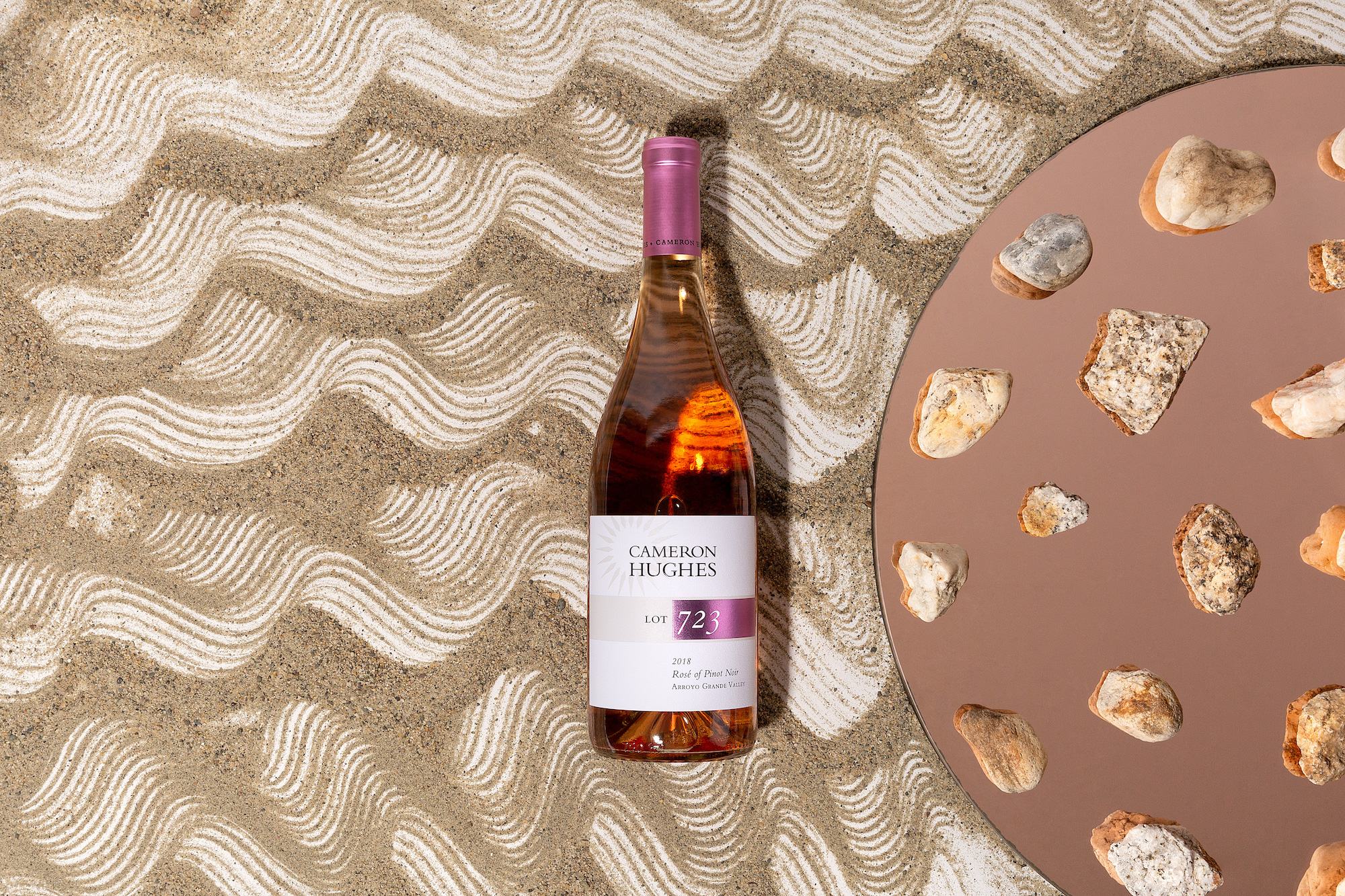
科甘說,她最近遇到了一名來自于得州的客戶,后者告訴她已經預定了一箱[Cameron Hughes]桃紅作為其“夏季門廊酒”,因為它非常清爽,而且口感很好。她解釋說:“消費者通常會選擇桃紅而不是白葡萄酒,因為它能夠讓飲用者感到放松和清爽,它沒有加州主流白葡萄酒品種的陳釀感或酸感,很多葡萄酒飲用者認為這些白葡萄酒的口感太過了。”由其是霞多麗,因其橡木味和綿密感過重而失去了人們的好感,而長相思時常又由于草味和植物味過重而受到詬病。
然而,與白葡萄酒相比,桃紅給人的感覺更加親切一些,但在高溫季節飲用時并沒有紅葡萄酒的厚重感。科甘說:“我們通常在喝第一口之前便對桃紅的口感有了判斷,它應該有著微妙的紅色葡萄果味、清爽的回味以及往往較為順滑的口感。”
然而桃紅,由其是美國市場的桃紅,在改善了其自身不好的聲譽之后才擁有了今天的境地。
科甘說:“很長一段時間以來,可以追溯至上個世紀70年代,桃紅被認為是一種劣質葡萄酒,例如盒裝酒,通常是甜的。直到五年前,桃紅開始通過直銷渠道進行硬性推銷,而且通常不會對紅酒俱樂部發貨。對桃紅認知的改善以及直接讓消費者品嘗一直都是其走紅的關鍵。”(財富中文網)
譯者:Feb
有人稱,千禧一代扼殺了葡萄酒(連瓶塞都沒有放過)。不管是真是假,但桃紅肯定不在扼殺范圍之列。
相反,桃紅葡萄酒或許正是因為他們才得以崛起。數年前,很多反對者可能會認為桃紅只是曇花一現的事物,但它并未就此消亡。
國際葡萄酒及烈酒研究所的市場分析師萊恩·李說:“在過去很長一段時間里,美國人認為桃紅是一種甜美、果味十足的葡萄酒,其種類因為接受度不高而較為單一。法國生產商通過數年的時間成功地營銷并擴大了桃紅品嘗活動,并借此改變了美國消費者對桃紅的看法。此舉幫助提升了人們對這類酒品的興趣,并極大地豐富了桃紅的品種數量。如今,桃紅已經成為了家喻戶曉、深受人們喜愛的酒品,而且越來越多的生產商,尤其是本土生產商都推出了自有的桃紅干紅。”
然而,盡管法國普羅旺斯產區是桃紅的代言詞,而且美國消費者對桃紅的興趣日漸高漲,但他們也在學習,然后向外延伸,并從其他產區購買桃紅。他們不僅放眼美國和其他新世界紅酒生產商,還將目光瞄向了法國在歐洲的鄰國。這些國家有著類似的氣候,也能夠生產類似品質的紅酒,但單瓶或每箱的價格通常會低很多。
這些紅酒生產商如今有充分的理由來投資桃紅釀造。尼爾森公司稱,美國桃紅酒的銷售額在過去三年中一直保持著同比增長,2019年的增速達到了42%。
國際葡萄酒及烈酒研究所的數據顯示,2019年,桃紅佐餐酒的銷量同比增長了3.2%,而無氣葡萄酒整體出現了1%的下滑。在過去五年中(從2014年到2019年),桃紅斬獲了1.7%的復合年增長率,而整個無氣葡萄酒行業為0.8%。
這家市場研究公司調查了新冠疫情爆發之前桃紅的非現場飲用銷售額,發現其銷量在過去三個月中出現了大幅增長。然而分析師稱,這種從現場飲用(酒吧和餐館)向非現場飲用(零售)轉變,而不是行業整體增長的現象更具代表性。(尼爾森的美國非現場飲用的全口徑衡量渠道包括百貨店、藥店、大型商超、精選一美元店、精選倉儲俱樂部、軍方供應、便利店和烈酒店。)
美國本土佐餐酒的增速要高于進口酒,也帶動了桃紅的整體銷量,但價位卻更低。來自于意大利的桃紅在美國的銷量尤為強勁,銷售額同比增長了近20%,尤其是8美元至11美元的價格區間的桃紅。另一種銷量名列前茅的佐餐桃紅來自于新西蘭,其銷售額同比增長了16%,主力產品位于11美元至15美元的價格區間。
尼爾森的酒精飲品行業高級副總裁丹尼·布拉格說:“法國佐餐桃紅在美國的非現場飲用領域依然在增長,尤其是高價位酒,但其市場份額正在下滑。”國際葡萄酒及烈酒研究所稱,截至2020年2月,法國桃紅銷售份額同比實際上下降了1.7個百分點。去年美國市場上的法國無氣葡萄酒整體銷量下滑了4.9個百分點。
不管怎么樣,法國依然是桃紅市場的霸主,在美國桃紅佐餐酒前十大進口國榜單中排名第一,意大利、新西蘭、西班牙、葡萄牙、阿根廷、智利、澳大利亞、南非和德國緊隨其后。
盡管市場上也有普通價格的法國桃紅,但大多數都屬于高檔酒系列(按照國際葡萄酒及烈酒研究所定義,超過10美元/瓶的葡萄酒)。
李表示:“法國桃紅對于普通消費者來說還是偏貴。”國際葡萄酒及烈酒研究所的研究顯示,美國桃紅佐餐酒平均零售價格為8.32美元。“作為對比,美國本土酒莊生產的桃紅價格更具吸引力。本土酒莊額外的庫存和供給過剩也為新的高品質品牌進入美國市場創造了機會,而且這些品牌的價格比以往更低。”
如今,似乎有無窮無盡的新桃紅品牌在等著消費者去發現。葡萄酒進口商Evaton專營伊比利亞佐餐酒,其首席執行官史蒂芬·布勞爾說:“消費者愿意花更多的錢購買桃紅,但桃紅本身的特質才是讓他們成為回頭客的真正原因。幸運的是,人們無需花太多的錢便可以享用到優質桃紅。”
桃紅類酒品之所以大獲成功,千禧一代比其他年齡段的人士功勞更大。桃紅全球跟蹤網站稱,在過去17年中,桃紅在全球的銷量一直在飆升,2002年至2018年的增速達到了40%。布勞爾說,美國市場的千禧一代消費者想要的是輕盈、口感好的葡萄酒,同時這也是他們追求的生活方式。他說:“桃紅不僅僅是一款夏季飲品,它的特別之處在于價格親民。粉紅色的酒體能夠給任何場合帶來歡愉,適合各種預算類型的消費者。”
瓶中信息
在消費者繼續尋找下一款劃時代酒品之際,葡萄牙成為了首選替代目標。在新冠疫情爆發以及還未出現非必要旅行這個問題之前,大批美國民眾如潮水般涌向葡萄牙。最近幾年,葡萄牙成為了頂級旅游勝地,而且被世界旅游大獎連續三年(2017-2019)評選為歐洲最佳旅游勝地。《葡萄酒愛好者》還將其評選為2019年10大最佳紅酒旅游勝地。
布勞爾說:“人們在葡萄牙發現,紅酒的性價比出奇的好。桃紅近些年的走紅也源于市場在售桃紅整體品質的大幅提升,而且桃紅的適用場合亦非常廣泛。在全球范圍內,桃紅可以用于勾兌雞尾酒,作為開胃酒,或作為多種夏季菜肴的佐餐酒。”
葡萄牙紅酒制造商蘇加比集團的美國分公司Evaton正在慶祝其Mateus桃紅干紅的重新推出。Mateus是葡萄牙首要的家族酒莊,位于波爾圖東北部,也是蘇加比集團旗下的頂級酒莊之一。1942年,最初的Mateus桃紅被設計和開發為一款甜美的氣泡酒。隨著這些年消費者口味的變化,Mateus也隨之進行了調整(主要針對美國市場),并推出了首款桃紅干紅。布勞爾說:“借助Mateus桃紅干紅,我們根據當前消費者的口味調整了紅酒的口感,而且相信這款不俗的產品可以與法國普羅旺斯頂級桃紅相抗衡。”
Mateus的葡萄酒業務主任安東尼奧·布拉加說:“在我們生產的所有桃紅中,我們最看重的一個元素就是可飲用性,也就是將優雅、迷人的風味和平衡度融于一體。以Mateus桃紅干紅為例,我們追求的是新鮮、果味表達以及完整的酸度,這些都能帶來絕佳的口感。”
Mateus現已進駐120多個市場,其最大的市場還是其產地葡萄牙。當地的消費能力十分強勁,從2010年的17.9萬箱增至2019年的27.5萬箱。
但美國是Mateus干紅桃紅的唯一市場。蘇加比集團執行委員會委員拉奎爾·瑟布拉說:“在美國,我們根據美國人的口感需求采取了一種不同的前衛方式,并開發了一款干紅桃紅,這是一款有著淺粉酒體,甜度更低的葡萄酒。我們非常專注于通過數字手段來開發品牌,并投入了很多精力來打造我們的社交渠道,我們認為這類渠道體現了Mateus所要表達的生活真諦。粉紅色的葡萄酒、標志性的包裝,以及愛意滿滿的品牌形象這個完美組合有助于我們在社交媒體領域吸引我們的核心目標消費者。”
瑟布拉還提到了在美國消費者心目中大獲成功的幾個外形因素,尤其是其187毫升的瓶體(作為對比的是平均750毫升的標準瓶體)。瑟布拉說:“對消費者來說,這個量在任何場合都是剛剛好,而且瓶體的形狀也是十分獨特。”她解釋說,這個瓶體是一戰期間士兵們所攜帶酒瓶的再現。
未開發的潛力
尋求意大利夏季飲品的美國民眾如今可能只能選擇阿佩羅雞尾酒。然而,受益于這款Instagram推崇的雞尾酒,意大利桃紅葡萄酒的產量得以大幅提升,而且其銷量近些年來在本土市場以及歐盟和美國市場也迎來了迅猛增長。
Chiaretto是一款有著清爽口感的干紅桃紅,其原料為紅葡萄,采用了白葡萄酒的釀造工藝,產自米蘭和威尼斯之間的加爾達湖周邊地區。(其名稱Chiaretto源于意大利語chiaro,意為“淺色”、“蒼白”。)
加爾達湖是意大利桃紅最重要的產區,每年平均產量超過了1000萬瓶,而桃紅占意大利紅酒市場總量的6%。盡管遭遇新冠疫情,但桃紅的上揚趨勢有望得以延續,而該產區在2020年第一季度發送了260萬支Chiaretto,較2019年第一季度增長了50萬支。
Cantina Gorgo酒莊位于加爾達湖東南部。得益于意大利和海外市場,其Chiaretto銷量在過去三年中增長了60%。該酒莊的主要市場是廣大的歐盟地區,主要是德國。但Gorgo酒莊的聯合所有者、紅酒釀造商羅伯塔·布里克羅稱,最大和最近的訂單需求均來自于美國(尤其是紐約和馬薩諸塞州)、加拿大和英國,同時連鎖超市維特羅斯(Waitrose)已經將Gorgo Chiaretto葡萄酒擺上了旗下所有店面的貨架。
布里克羅說,盡管消費者的初戀可能一直是普羅旺斯產區的桃紅,但她認為全球市場還存在大量未挖掘的潛力。她補充說:“公司崛起的關鍵在于引入意大利在桃紅領域的專長和風味。”
離Gorgo不遠的Cavalchina也迎來了其桃紅銷量的激增,而Chiaretto是其最暢銷的酒品之一。這家酒莊平均每年生產80萬箱葡萄酒,其中有半數出口。但唯一的問題在于,這家酒莊每年的酒都會售罄。2019年,意大利、歐盟地區和美國買光了Cavalchina所有的桃紅,而且酒莊發現這些市場的需求仍在上漲。
盡管銷量在不斷增,擁有110公頃(約合272英畝)的皮奧納家族并不打算擴張或購買更多的土地,因為他們希望這個家族業務能夠可持續地發展下去。
弗朗西斯科·皮奧納說:“說真的,我認為這些趨勢一直都是起起伏伏,目前桃紅也在經歷這一現象。”弗朗西斯科的父親路西阿諾與其兄弟于1962年創建了酒廠。銷售業績顯示,桃紅在近期的需求依然堅挺。但Chiaretto尤為特殊的一點在于,它是少數能夠陳釀的桃紅之一,而且如果放置數年后口感會更好。皮奧納說:“市場需要淺齡酒,但我們的桃紅可以陳釀兩到三年的時間。”
良好的聲譽
美國并不像意大利加達爾湖和法國普羅旺斯那樣有特定的桃紅產區。但行業專家認為加州和俄勒岡州是其有力的競爭對手,涵蓋從圣路易斯奧比斯波一直到威拉梅特谷的地區。
舊金山灣區Cameron Hughes Wine與 Vintage Wine Estates的首席營銷官杰西卡·科甘認為,美國式的桃紅“通常更為順滑和現代”。大多數在這里釀造的桃紅都是干紅,而且通常酒精度較低,也讓其更為適合夏季飲用。
科甘說:“大多數消費者想要一款加州產桃紅,其唯一能感知的甜度來自于葡萄本身的天然紅色水果風味。很多消費者認為桃紅是一種更加純粹的飲酒體驗,因為這種葡萄酒可以輕易地與各種食品搭配,也十分適合獨飲。”
科甘說,她最近遇到了一名來自于得州的客戶,后者告訴她已經預定了一箱[Cameron Hughes]桃紅作為其“夏季門廊酒”,因為它非常清爽,而且口感很好。她解釋說:“消費者通常會選擇桃紅而不是白葡萄酒,因為它能夠讓飲用者感到放松和清爽,它沒有加州主流白葡萄酒品種的陳釀感或酸感,很多葡萄酒飲用者認為這些白葡萄酒的口感太過了。”由其是霞多麗,因其橡木味和綿密感過重而失去了人們的好感,而長相思時常又由于草味和植物味過重而受到詬病。
然而,與白葡萄酒相比,桃紅給人的感覺更加親切一些,但在高溫季節飲用時并沒有紅葡萄酒的厚重感。科甘說:“我們通常在喝第一口之前便對桃紅的口感有了判斷,它應該有著微妙的紅色葡萄果味、清爽的回味以及往往較為順滑的口感。”
然而桃紅,由其是美國市場的桃紅,在改善了其自身不好的聲譽之后才擁有了今天的境地。
科甘說:“很長一段時間以來,可以追溯至上個世紀70年代,桃紅被認為是一種劣質葡萄酒,例如盒裝酒,通常是甜的。直到五年前,桃紅開始通過直銷渠道進行硬性推銷,而且通常不會對紅酒俱樂部發貨。對桃紅認知的改善以及直接讓消費者品嘗一直都是其走紅的關鍵。”(財富中文網)
譯者:Feb
It’s been charged that millennials killed wine (right down to the cork). Regardless of how true or not that might be, they certainly haven’t killed rosé.
On the contrary, they’re probably responsible for its revival. And while many naysayers might have thought rosé was a flash in the pan a couple of years ago, it’s not fading to black.
“For a long period in the U.S., rosé wine had an image of being a sweet, fruity wine, which held the variety back from greater acceptance,” says Ryan Lee, IWSR market analyst. “French producers successfully marketed and expanded tastings over a number of years to change the American consumer’s perception of what rosé wine is. This has helped grow interest in the category and greatly increase the number of rosés available. Now that rosé wine is widely known and adored, more producers—especially domestic producers—have their own dry rosés.”
But while France’s Provence region is synonymous with rosé, as U.S. consumers further latch onto the pink-hued wine, they’re learning, branching out, and purchasing rosé wines from other regions. They’re looking not only across the U.S. and toward other New World winemakers but also toward France’s neighbors in Europe, which share similar climates and produce comparable quality wines, but often charge far less per bottle or case.
These winemakers have good reason to invest in rosé production right now. Dollar sales of rosé wine in the United States have grown year over year annually for the past three years, most recently by 42% in 2019, according to Nielsen.
Volume growth for rosé table wine grew 3.2% in 2019 year over year, compared with an overall decrease of 1% for still wine last year, according to IWSR data. Red wine decreased 0.9% and white wine dropped by 1.9%. Over the past five years (from 2014 through 2019), rosé has demonstrated a 1.7% compound annual growth rate, while total still wine has posted growth of 0.8% CAGR.
The market research firm examined off-premises dollar sales of table rosé before the impacts of COVID-19 accelerated, as sales in the past three months have spiked significantly. But analysts say that is more representative of a shift from the on-premises space (bars and restaurants) to off-premises (retail) rather than total industry overall gains. (Nielsen’s total U.S. off-premises measured channels include grocery stores, drugstores, mass merchandisers, select dollar stores, select warehouse clubs, military commissaries, convenience stores, and liquor stores.)
Domestic (U.S.) table rosé is growing faster than imported table rosé—increasing its share of total rosé sales, but at lower price points. Table rosés from Italy are performing particularly well in the U.S., with nearly 20% year-over-year dollar sales growth, primarily in the $8 to $11 bottle range. Another top performer is New Zealand table rosé, which is experiencing 16% year-over-year dollar sales growth, driven by the $11 to $15 price range.
“French table rosé is still growing in the U.S. off-premises space—particularly at a higher price point—but is losing share,” says Danny Brager, senior vice president of beverage alcohol at Nielsen. French rosé dollar sales share actually declined 1.7% year over year as of February 2020. And total French still wine in the U.S. was down 4.9% in volume last year, according to ISWR.
Nevertheless, France still remains supreme in rosé, ranking No. 1 on the list of the top 10 importers of rosé table wine to the U.S., followed by Italy, New Zealand, Spain, Portugal, Argentina, Chile, Australia, South Africa, and Germany.
While there are French rosés on the market at standard prices, most fall within the premium segment (defined by IWSR as over $10 per bottle).
“French rosé wine is expensive for your average consumer,” Lee notes. According to IWSR research, the average retail price of a bottle of rosé table wine in the U.S. is $8.32. “Domestic (U.S.) producers are bringing to market products at more attractive price points, by comparison. The domestic producer’s additional inventory and supply surplus also allows for new, higher-quality brands to enter the market at lower prices than in years’ past.”
And the sheer number of new rosés for consumers to discover seems endless these days. “Consumers are willing to pay more for a rosé, but it’s the wine profile that keeps them coming back,” says Stephen Brauer, CEO of wine importer Evaton, which specializes in Iberian table wines. “Fortunately, you don’t have to spend a lot of money to enjoy a wonderful rosé.”
Millennials, more than any other demographic, have been a key driver for the rosé category’s success. Global consumption of rosé wine has soared in 17 years, growing 40% between 2002 and 2018, according to Rosé Wines World Tracking. Within the U.S. market, Brauer says millennial consumers are looking for light and easy drinking wines, but they are also looking for a lifestyle. “More than just a summertime drink, rosés offer something special that is affordable and accessible,” he says. “Pink makes every occasion glamorous, regardless of your budget.”
Message in a bottle
As consumers continue to look for the next big thing, Portugal is a prime alternative. Before the outbreak of COVID-19, when nonessential travel was not an issue, Americans were flocking to Portugal at staggering numbers. In recent years, Portugal became a top travel destination and has been dubbed the Best European Tourist Destination by the World Travel Awards three years in a row (2017 through 2019). Plus Wine Enthusiast named it one of the 10 Best Wine Travel Destinations in 2019.
“What people find in Portugal are phenomenal wines at an unbelievable value,” Brauer says. “The popularity of rosé in recent years can be attributed to the considerable improvement in overall quality of rosé wines that can now be found on the market and also the wine’s amazing versatility. Around the world, consumers enjoy rosé in cocktails, as an aperitif, or as an accompaniment to a variety of summer meals.”
Evaton, the U.S. arm of Portugal-based wine producer Sogrape Vinhos, is celebrating the relaunch of a dry rosé from Mateus, a leading Portuguese family-owned winery to the northeast of Porto, and one of the top producers within the Sogrape portfolio. The original Mateus rosé was conceived and developed as a sweet and slightly effervescent wine in 1942. As consumer tastes have changed over the years, Mateus adapted—primarily for the U.S. market—with its first dry-style rosé wine. “With Mateus dry rosé, we have adapted our wine style to current consumer tastes and believe we offer a wonderful product that can compete with the top French Provence rosés,” Brauer says.
“One of the most important elements that we look for in all of our rosé wines is drinkability, which combines elegance, delicious flavors, and balance," says António Braga, enological director at Mateus. “In the specific case of Mateus dry rosé, we are looking for freshness, fruit expression, and integrated acidity, [which] will deliver a wonderful mouthfeel.”
Mateus is available in over 120 markets, with its top market being its home country of Portugal. And local consumption has been strong, growing from 179,000 cases shipped in 2010 to 275,000 cases in 2019.
But the U.S. is the only market where the Mateus dry rosé is launching. “In the U.S., we took a bold, different approach given the American taste profile and developed a dry-style rosé, that is a lighter pink color and less sweet,” says Raquel Seabra, an executive board member of Sogrape. “We have really focused on bringing our brand into the digital space and have placed a lot of our efforts in building our social channels that we believe capture the true lifestyle essence of Mateus. The pink wine, the iconic packaging, and the overall love of the brand has been perfect in the social media landscape for reaching our core target consumer.”
Seabra also points to the success of multiple form factors among U.S. consumers, especially 187 milliliter bottles (versus an average of 750 milliliters in a standard bottle of table wine). “The bottle size allows consumers the perfect portion for any occasion, and the shape itself is quite unique,” Seabra says, explaining the bottle was designed to reflect the flasks worn by soldiers in World War I.
Untapped potential
Americans looking for an Italian summertime drink might be conditioned now to order an Aperol spritz. But in the shadow of the Instagram-approved cocktail, Italy has substantially grown its rosé wine production and sales both within its own market as well as across the European Union and the U.S. in recent years.
Made from red grapes using white-wine-making practices, Chiaretto is a dry and crisp rosé produced in the region surrounding Lake Garda, between Milan and Venice, in northern Italy. (The name Chiaretto derives from the Italian term chiaro, meaning “light” or “pale.”)
Lake Garda is the most important region for rosé in Italy, producing more than 10 million bottles annually on average, and rosé makes up 6% of the Italian wine market. That upward trend is poised to continue in spite of the coronavirus pandemic, as the region shipped 2.6 million bottles of Chiaretto during the first quarter of 2020—half a million more than in the first quarter of 2019.
Cantina Gorgo, a wine estate southeast of Lake Garda, has seen its Chiaretto sales shoot up 60% in the past three years, thanks to sales in Italy and abroad. The winery’s primary market is the wider European Union—notably Germany. But Gorgo co-owner and winemaker Roberta Bricolo says the largest and most recent order requests have been from the U.S. (especially New York and Massachusetts), Canada, and the U.K. as supermarket chain Waitrose has added Gorgo Chiaretto wines to all of its locations.
While consumers’ first love might have been Provence rosé, Bricolo says, she thinks there is a lot of untapped potential in the global market. “The key for us to emerge was to introduce the Italian flair and flavor to the rosé scene,” she adds.
Cavalchina, just down the road from Gorgo, has also seen its rosé sales soar, and Chiaretto is one of its bestsellers. The winery produces 800,000 cases per year, on average, and half of that is exported. The only problem: The winery sells out of its product every year. In 2019 Cavalchina sold all of its rosé within Italy, the wider EU, and the U.S., and it has observed increased demand across all of those markets.
And yet, despite the growing business, the Piona family doesn’t plan on expanding or buying more land beyond its 110 hectares (272 acres), because they want to keep it sustainable as a family business.
“Sincerely, I think that trends may come and go, and we are seeing that also for rosé wine,” says Francesco Piona, whose father, Luciano, was one of the two brothers who established the winery in 1962. Sales figures demonstrate that rosé definitely has near-term staying power, but what is extra special about Chiaretto is that it is one of the few rosés that does age well and is often received better if it is held for a few years. “The market wants a young wine, but you can age it two to three years,” Piona notes.
Rosy reputation
The U.S. doesn’t have one particular region dedicated to rosé production, akin to Lake Garda in Italy or France’s Provence. But industry experts point toward California and Oregon as competitive options, from San Luis Obispo up to the Willamette Valley.
Jessica Kogan, chief marketing officer of Cameron Hughes Wine and Vintage Wine Estates in the San Francisco Bay Area, suggests that the U.S. style of rosé is “generally more lush and modern.” And most rosés made here are dry and often lower in alcohol, making them more palatable for summer.
“Most consumers want a dry California rosé, where the only perceived sweetness is coming from the natural red fruit flavors from the grape itself,” says Kogan. “Many of our consumers consider rosé to be a more uncomplicated drinking experience as the wine can be easily paired with a variety of foods or enjoyed by itself.”
Kogan says she recently had a customer from Texas tell her he was ordering a case of [Cameron Hughes] rosé as his “summer porch pounder” because it was cool and easy to drink. “Consumers often choose rosé over white wines as it provides the wine drinker a chilled and refreshing experience without the oaked or acidic flavors of California’s leading white wine varieties that many wine drinkers find polarizing,” she explains. Chardonnay, in particular, has a rough reputation for being overly oaky and buttery, whereas a Sauvignon Blanc is oft criticized for being too grassy and vegetal.
Rosé, however, feels a bit heartier than a white wine, but not as heavy as a red on a warm day. “A rosé is usually understood before its first sip—the drinker can anticipate its subtle red fruit, its crisp finish, and its often smooth mouthfeel,” Kogan says.
But rosé—especially in the U.S.—had to overcome a poor reputation of its own to get where it is now.
“For quite some time, dating back to the 1970s, rosé was considered inferior wine—think boxed wine, often sweet,” Kogan says. “Up until five-ish years ago, rosé was definitely a hard sell through the direct-to-consumer channel and not typically included in wine club shipments. Improved education and simply getting it in customers’ hands has been key.”













